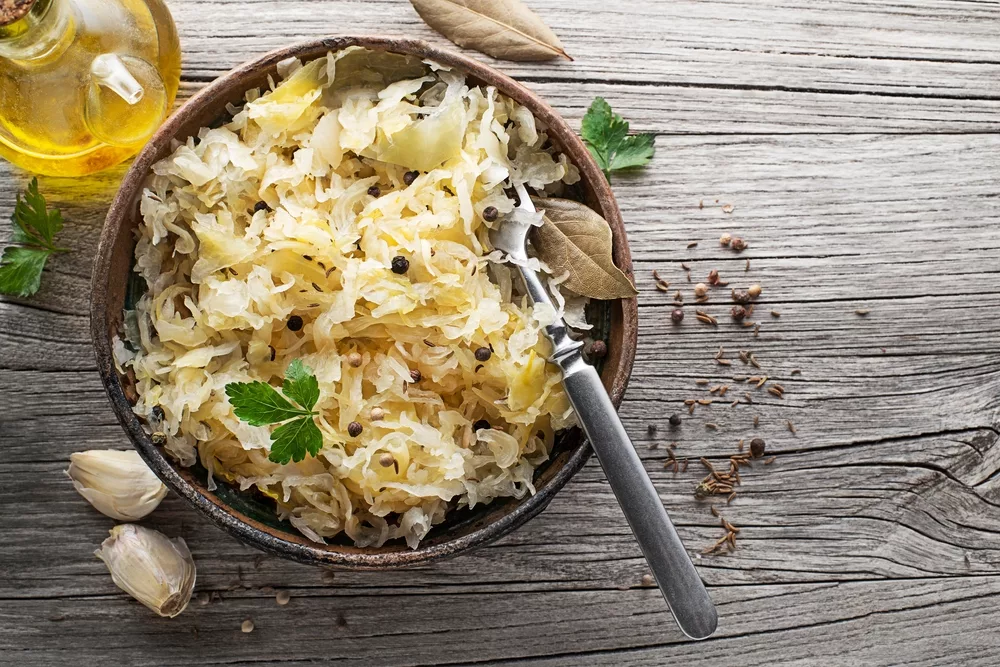
Sooo… it’s that time of year for richly flavored braised dishes. Unless one grew up in a Germanic family of some sort, sauerkraut may be unfamiliar. The evolution of sauerkraut or “sour cabbage” developed as a way of preserving cabbage through the winter and is also a traditional ingredient in both middle and eastern European cooking. In that part of the world sauerkraut is not only delicious as an accompaniment to rich smoked and roasted meats but is also used as a basis for salad and even breads. Probably the most famous sauerkraut dish is from Alsace in France: choucroute garnie, which is kraut served with bacon, smoked sausages and potatoes.
Making sauerkraut at home is an easy process and the resulting kraut can be stored in the refrigerator for several months. I promise it will be so much better than most of the commercial products in the market. The process takes a few weeks depending on temperature, so plan ahead.
The key to making sauerkraut at home is to make sure everything is absolutely clean. I suggest using a 5-gallon plastic tub in which to ferment sauerkraut. Constant, cool temperature is also important (65 or so degrees). If the fermenting kraut gets above this then it can spoil. True kraut lovers believe that the lower the constant temperature the better the flavor. At 45 degrees it can take several months for the cabbage to fully ferment. The following will give you 6 to 8 quarts of finished sauerkraut. What to serve with it? I’ve included a favorite recipe below for bockwurst braised in ale with homemade sauerkraut.
Method
15 pounds (6 to 8 firm heads) green cabbage
3/4 cup kosher or pickling salt
Wash the cabbage thoroughly and trim away any bruised or damaged leaves. Quarter and cut away the core and discard. With a food processor, mandoline or knife, cut the cabbage into uniformly fine shreds.
In a large plastic tub, place half the cabbage and sprinkle with half the salt. Mix and “massage” the cabbage and then let it stand for 5-10 minutes. Juices will begin to come out of the cabbage. Place this in your fermenting tub. Repeat process with remaining cabbage and salt and pack into tub.
The cabbage must be covered by juices to prevent spoilage. If there is not enough juice to cover make up some additional brine by adding 4 tablespoons salt to 2 quarts water, pouring over just to cover. You are looking for a mixture which has about 3% salt by weight.
Be sure to keep cabbage submerged during fermentation. A clean plate which is the same diameter as the fermenting tub is ideal as a weight to keep the cabbage submerged. Cover the tub securely with a lid or plastic wrap and then cover that with a clean towel to keep out any errant contamination.
Store in a 65 or so degree room and don’t uncover for at least three weeks. Remove towel and plastic wrap. There should be no bubbles of CO2 gas evident in the brine (gently tap tube to check). If there is, recover and check again in five days. The whole process will take four to eight weeks. If you see that the plate weighing the cabbage down is covered by a somewhat slimy layer of liquid then skim it off. This is dextran, which is a bacterial byproduct from the fermentation and, if left there, can become a home for unwanted organisms.
The finished sauerkraut should have a clean appearance with no white spots or unpleasant or off odors. Texture should be firm. Pack finished sauerkraut into clean jars and store in refrigerator for up to six months. If you find that the resulting kraut is too salty or acidic for your taste, then simply rinse it for a milder version.
Usually, homemade sauerkraut is cooked a bit before it’s eaten. Often it’s flavored with juniper berries or fruits like apples or quince as it cooks. Here’s a recipe to start using up that delicious kraut!
ALE BRAISED BOCKWURST WITH SAUERKRAUT
Serves 6
4 cups fresh sauerkraut, preferably homemade
1-1/2 cups apple juice or cider
1 teaspoon whole caraway seeds
Salt and freshly ground pepper to taste
3 bottles good, dark ale
2 bay leaves
6 whole cloves
1 tablespoon brown sugar
2 pounds fresh bockwurst or other white sausage
Sweet-hot or grainy mustard of your choice
Drain sauerkraut; rinse if it is too strong. Add to a non-reactive saucepan along with apple juice, caraway seeds and salt and pepper to taste. Simmer slowly, partially covered for 20-30 minutes or until most of the juices are absorbed. Keep warm.
Add ale, bay leaf, cloves, sugar, salt and pepper to a separate saucepan and simmer for 3-4 minutes. Add bockwurst and simmer slowly, covered for 4-5 minutes or until warmed through and plump.
To serve: Mound sauerkraut on warm plates and top with steamed bockwurst and a big dollop of your favorite mustard.




